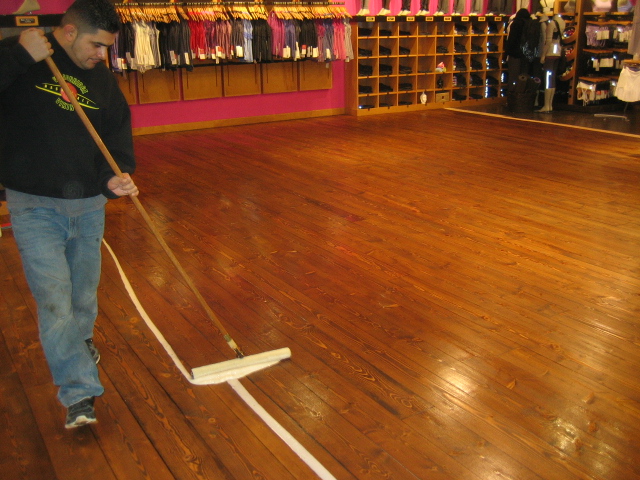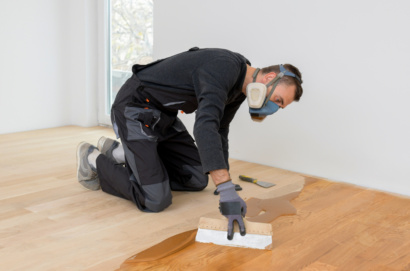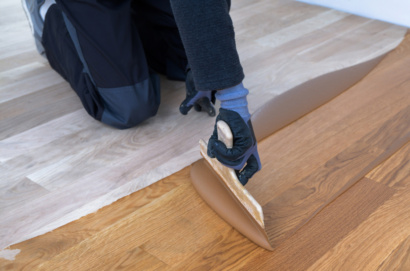Wood floor staining is an artistic and transformative process that allows homeowners and interior designers to customize and enhance the beauty of hardwood floors. With an array of stain types, colors, applications, and techniques available, the possibilities for creating unique and stunning flooring designs are virtually endless. In this post, we’ll explore the art of wood floor staining, discussing the different types of stains, colors, application methods, and techniques to inspire your next flooring project.
Types of Wood Floor Stains
a) Oil-Based Stains: Oil-based stains are a popular choice due to their deep penetration into the wood, highlighting the natural grain patterns and providing a rich and timeless look. They are available in a wide range of colors and can be easily blended to achieve custom shades.
b) Water-Based Stains: Water-based stains are known for their low VOC content, making them a more environmentally friendly option. They dry quickly, are easy to clean up, and offer a vast selection of colors. However, they may not penetrate as deeply into the wood as oil-based stains.
c) Gel Stains: Gel stains have a thicker consistency compared to traditional stains, making them ideal for vertical surfaces like hardwood floors. They provide even coloring and are great for achieving a consistent finish on porous and non-porous wood species alike.
d) Water-Pop Stains: Water-popping involves applying water to the wood surface before staining to open up the wood pores and allow for better stain absorption. This technique can result in more vibrant and uniform coloration.
Exploring a Palette of Colors
Wood floor stains come in a broad spectrum of colors, ranging from light and natural tones to dark and dramatic hues. Some popular stain colors include:
a) Classic Oak: A timeless choice, oak stains come in various shades like golden oak, red oak, and white oak, allowing homeowners to complement different design themes.
b) Rich Mahogany: Ideal for creating a luxurious and elegant ambiance, mahogany stains add warmth and depth to any space.
c) Espresso and Ebony: For a bold and contemporary look, deep brown and ebony stains deliver sophistication and contrast against light-colored furnishings.
d) Whitewash and Gray: Offering a modern and airy feel, whitewash and gray stains are perfect for achieving a rustic or coastal aesthetic.
Application Methods and Techniques
a) Brushing: Brushing on the stain is a traditional method that involves applying the stain with a brush and then wiping away excess to achieve an even finish. This technique allows for more control over the stain’s intensity and can highlight wood grain.
b) Ragging: Using a soft cloth or rag to apply the stain allows for a softer and more blended look, particularly when using gel or water-based stains.
c) Spraying: Spraying the stain can provide a more uniform and consistent coloration, especially for large flooring areas. However, it requires proper equipment and skill to avoid overspray.
d) Layering: Layering different stain colors or applying multiple coats can result in unique effects, such as antique or distressed finishes, adding depth and character to the wood.
Tips for Achieving the Perfect Stain
a) Prepare the Wood: Properly sand and clean the wood surface before staining to ensure the stain adheres evenly and avoids blotchy results.
b) Test Samples: Always test the stain on a small, inconspicuous area or a wood sample to see how it reacts with the wood species and to determine the desired color.
c) Work in Sections: When staining larger floor areas, divide the space into sections and complete one section at a time to maintain a consistent application.
d) Seal and Protect: After staining, apply a high-quality sealer or topcoat to protect the stained wood from wear, scratches, and moisture damage.
Conclusion
Wood floor staining is an art form that allows homeowners and designers to infuse their spaces with personality, style, and creativity. With a plethora of stain types, colors, application methods, and techniques available, achieving the perfect look for your hardwood floors is within reach. By understanding the various stain options and experimenting with different application techniques, you can create stunning and customized flooring designs that will be the centerpiece of any room. So, unleash your creativity, and let the art of wood floor staining bring new life to your living spaces.
Looking for a hardwood flooring company to bring your wood floors back to life? Get a free flooring quote from FloorU today.




